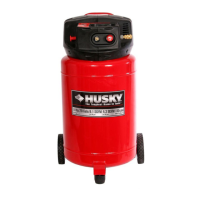
Do you have a question about the Husky H1820F and is the answer not in the manual?
| Brand | Husky |
|---|---|
| Model | H1820F |
| Category | Air Compressor |
| Language | English |
Warning about using the compressor for breathing air, requiring additional filtration and purification equipment.
Guidelines for maintaining a safe and clean work area, free from hazards like flammable atmospheres.
Precautions for safe electrical connections, avoiding water, and proper cord handling.
Ensuring eye protection, proper attire, and maintaining situational awareness during operation.
Guidelines for safe operation, proper footing, and tool maintenance.
Instructions for servicing the tool, emphasizing the need for qualified technicians.
Rules to prevent fire and explosion risks when using the compressor, especially with flammable liquids.
Guidelines to avoid exceeding pressure limits for attachments and the compressor.
Specific rules to prevent electric shock, including cord inspection and outdoor use.
Instructions for yearly tank inspection and ensuring hoses are free from snags.
Guidelines on intended use, avoiding unattended operation, and checking warning labels.
Detailed advice on selecting the correct gauge and condition for extension cords.
Warning about chemicals known to cause cancer or birth defects in California.
Explanation of symbols related to electrical specifications like Volts, Amperes, and Hertz.
Interpretation of symbols indicating safety alerts, eye protection, and various hazards.
Understanding the meaning of signal words to assess risk levels.
Guidelines for safe servicing and the importance of using qualified personnel.
Chart and advice for choosing the correct extension cord gauge based on length and amperage.
Instructions for proper grounding and connecting the compressor to a power outlet.
Key technical details including horsepower, tank capacity, pressure, and air delivery.
Labeled diagram identifying the main parts of the air compressor.
Familiarization with key features like the oil-free motor, regulator, and safety valve.
Steps for safely unpacking the unit and verifying all parts are present and undamaged.
Ensuring all items listed in the packing list are included before assembly.
Detailed steps for securely attaching the wheels and rubber foot to the compressor base.
Instructions for attaching the air hose and quick coupler to the compressor's air outlet.
Procedure for the initial 10-minute run-in of the pump for proper operation.
Warnings and precautions to ensure safe operation of the air compressor.
Examples of uses for the air compressor, matching tools to its capabilities.
Instructions for connecting and operating the compressor with air-powered tools.
Importance of verifying air tool requirements against compressor capacity.
Guidance on controlling airflow with the pressure regulator for inflation tasks.
Procedures for safely shutting down the unit, including draining and unplugging.
Instructions for draining moisture from the tank to prevent corrosion and maintain air quality.
Procedure for checking the safety valve's functionality before each use.
Routine maintenance including draining condensate and checking safety valve.
Procedure for inspecting the air tank for rust, pinholes, or other damage.
Recommendations for cleaning plastic parts without causing damage.
Warnings about chemicals and materials that can damage plastic parts or the tool.
Details regarding the compressor's permanent bearing lubrication.
Diagnosing and resolving issues related to the compressor not starting or running at reduced speed.
Troubleshooting causes and solutions for repeated circuit breaker trips or blown fuses.
Addressing situations where the thermal overload protector repeatedly shuts off the compressor.
Identifying reasons for air pressure drops in the receiver after the compressor stops.
Solutions for problems like excessive moisture in discharge air or continuous compressor running.
Troubleshooting steps for compressor vibration and low air output issues.
